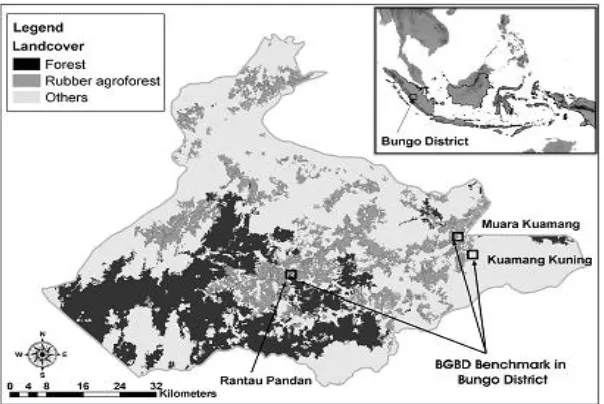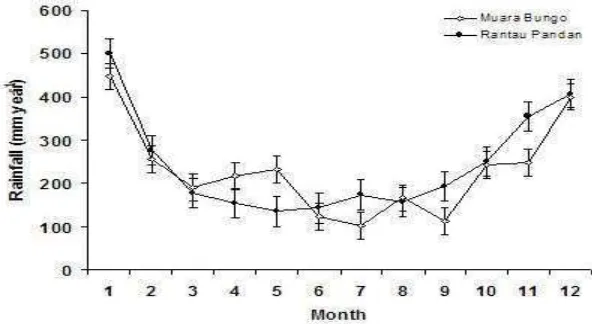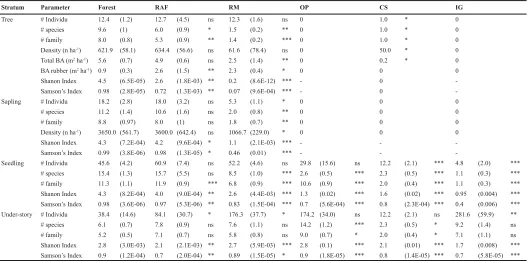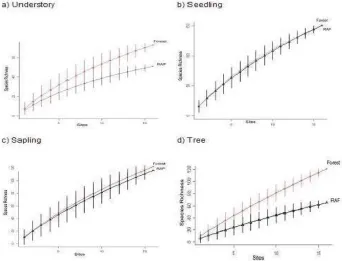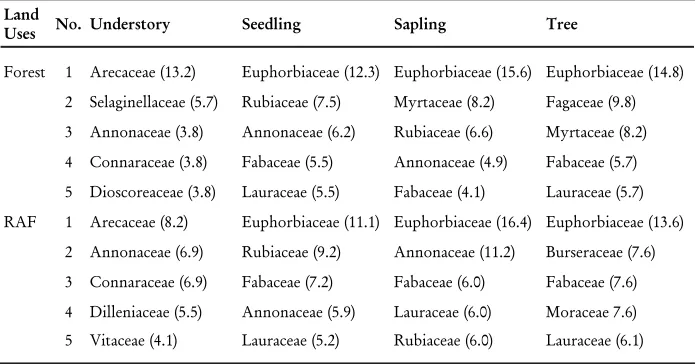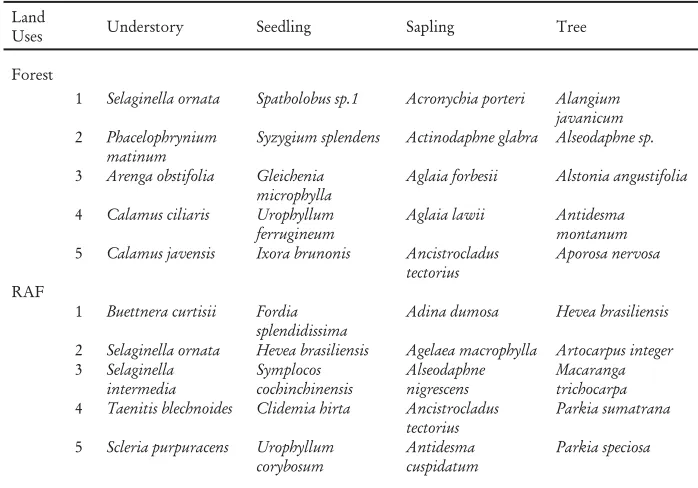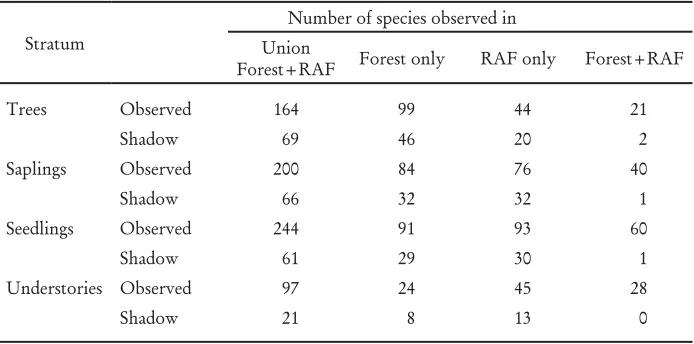1
TREES AND REGENE RATION IN RUBBER AGROFORESTS
AND OTHER FOREST-DERIVED VEGETATION IN JAMBI
(SUMATRA, INDONESIA)
Hesti L. Tata1,2, Meine van Noordwijk3 and Marinus Werger4
ABSTRACT
The rubber agroforests (RAF) of Indonesia provide a dynamic interface between natural processes of forest regeneration and human’s management targeting the harvesting of latex with minimum investment of time and Þ nancial resources. The composition and species richness of higher plants across an intensiÞ cation gradient from forest to monocultures of tree crops have been investigated in six land use types (viz. secondary forest, RAF, rubber monoculture, oil palm plantation, cassava Þ eld and Imperata grassland) in Bungo, Jambi Province, Indonesia. We emphasize comparison of four different strata (understory, seedling, sapling and tree) of vegetation between forest and RAF, with speciÞ c interest in plant dependence on ectomycorrhiza fungi. Species richness and species accumulation curves for seedling and sapling stages were similar between forest and RAF, but in the tree stratum (trees > 10 cm dbh) selective thinning by farmers was evident in a reduction of species diversity and an increase in the proportion of trees with edible parts. Very few trees dependent on ectomycorrhiza fungi were encountered in the RAF. However, the relative distribution of early and late successional species as evident from the wood density distribution showed no difference between RAF and forest.
Keywords : Diversity indices, species richness, structure, tropical secondary forest
I. INTRODUCTION
Sumatra is the worlds’ Þ fth largest island and part of the biogeo graphical ‘Sundaland’ domain that is widely recognized for its high biodiversity. It harbours a wide variety of natural and derived vegetation types (Laumonier, 1997), from forestland shrub land, wet lands, agriculture and grassland. Although Sumatra is not as rich in Dipterocarpaceae as the island of Borneo, this tree family is still considered to be characteristic of the lowland forests and contributes 3.1% of total tree species diversity in Sumatra as against 6.3% in Borneo (Roos et al.,
1 Forest and Nature Conservation Research and Development Center, Jl. Gunung Batu No. 5,
P.O. Box 165, Bogor 16610, Indonesia
2 Corresponding author. E-mail: h.tata@cgiar.org
3 World Agroforestry Centre (ICRAF South East Asia), P.O. Box 161, Bogor 16001, Indonesia 4 Department Plant Ecology and Biodiversity, Utrecht University, Sorbonnelaan 16, Utrecht, the
2004). Most big trees in late successional stages of the lowland forests, such as Dipterocarpaceae and Fagaceae, have a close association with ectomycorrhiza (EM) fungi (Smits, 1994). In contrast, associations with endomycorrhizal (also indicated as arbuscular mycorrhiza) fungi mainly dominate in early successional trees and agricultural plants (Wang and Qiu, 2006). Early successional stages tend to have low wood density, while late successional trees usually have high wood densities (Swaine and Whitmore, 1988). So, distribution of the wood density of the trees in a mixed-vegetation can be used as an indicator of successional status. During the nineteen-nineties forest cover in Sumatra declined dramatically. The rate of deforestation or forest conversion in Sumatra was estimated to be about 61% within 12 years (FWI/GFW, 2001). In Bungo district in Jambi province alone, the conversion rate of forest areas was about 25% within 10 years, from 1993 to 2002 (Ekadinata and Vincent, 2005). Loss of forest biodiversity depends largely on the type of land cover to which the natural forest was converted (Gillison and Liswanti, 2004; Tomich et al., 2002). Some forest-derived land cover types still maintain substantial sub-sets of the original forest vegetation and approach the structure of secondary forests (Murdiyarso et al., 2002). From some derived land cover types the forest vegetation can still recover. From other, the loss of biodiversity is likely to be permanent on a relevant time scale of decades. As the late succession dipterocarp trees depend on EM, their recovery potential likely depends on the belowground as well as aboveground impacts of forest conversion on species persistence. Rubber agroforests (RAF) is the main forest-derived land cover type of interest in this regard.
3 Trees and Regeneration ... H.L. Tata et al.
(2003; 2005). However, none of the existing data sets has compared species richness in the different stages of tree regeneration (seedlings, saplings and trees) in relation to farmer management decisions.
Our analysis of tree and understory data collected in the Jambi project on the options for sustainable management of belowground bio diver sity quantiÞ ed the effect of land use on the composition and species richness of higher plants, with particular attention to plants with known dependency on EM, successional status of the tree species and applicability of the ‘shadow species’ concept (Rennols and Laumonier, 2006). Comparison of the seedling, sapling and tree strata focused on evidence of successful regeneration of forest diversity in agriculturally managed landscape units.
II. MATERIALS AND METHODS
A. Study area
Figure 1. Map of the study area in Bungo District, Jambi Province, Indonesia.
Bungo district has vegetation ranging from forest, agroforest, swamp forest along the river, tree crop plantations and agriculture (upland rice, maize, cassava and paddy rice). Some surveys were initiated in April 2005 for the Sustainable Management of Belowground Biodiversity (CSM-BGBG) project (Giller et al., 2005), with a ‘sampling window’ in the foothills in Rantau Pandan and two in the lowland peneplain in Muara Kuamang and Kuamang Kuning. Selection criteria for these approximately 25 km2 windows were the opportunity to capture diversity through the presence of a range of land use types. Sampling within the windows was done in an equidistant grid of points, with additional points to obtain a minimum number of replicates of all major land use strata. To implement this scheme, land cover in Bungo district was interpreted from satellite images of Landsat ETM taken in 2002. In total, 75 km2 of study area in Bungo district has been selected. The benchmark area was divided during the Þ eld inventory into six classes describing land use type (LUT) as follow: 1. Secondary forest: community managed forest used for extraction of timber
for local use and non-timber forest products, forests recovering from selective logging and mature untapped RAF, usually with low density of rubber trees
Trees and Regeneration ... H.L. Tata et al.
5 3. Rubber monoculture (RM); rubber monoculture with intensive management 4. Oil palm plantation (OP)
5. Cassava Þ eld (CS); when ß oristic inventories were conducted, all cassava had been harvested
6. Imperata cylindrica grassland (IG)
Relatively scarce land cover classes (river, road, and village) were excluded from the sample design. The number of sample points per land cover class varied between 5 and 12.
The ‘sampling window’ in Rantau Pandan and Muara Kuamang contained secondary forest (FO) and RAF, each represented by 8 sample plots in each window. Rubber monoculture (RM), was sampled in 6 plots each in Rantau Pandan and Kuamang Kuning. The other land uses, viz. oil palm (OP), crop cassava (CS) and Imperata grass land (IG), were only represented in Kuamang Kuning, with 5, 9, and 12 sample plots, respectively.
B. Plot size
In total seventy circular plots of 200 m2 (8 m in radius) were laid out. Each plot was divided into a subplot of 50 m2 (4 m in radius) and a subplot of 25 m2 (2.8 m in radius), nested within the larger plots. All strata of vegetation were recorded. The diameter at breast height (dbh; 1.3 m) of trees Ů 10 cm within circular plots of 200 m2 was measured. Saplings and woody climbers, with dbh less than 10 cm and height of more than 2 m, were recorded from the 50 m2 subplots. Similar data were collected for seedlings (consisting of shrubs and woody plants less than 2 m high) and understory (consisting of lianas, herbs, terrestrial ferns and grasses) were recorded within the 25 m2 subplots.
Herbarium specimens were collected from each individual tree, except very well known species, and deposited at the Herbarium of the World Agroforestry Centre (ICRAF-SEA). Herbarium specimens were identiÞ ed at the Herbarium Bogoriense, Bogor, Indonesia. Among all trees sampled in the 6 land use types in Bungo district (544 herbarium specimens), 88.2 % was identiÞ ed to species level, 5.0 % was identiÞ ed with a cf. note, 6.4 % was identiÞ ed at genus level, and the rest (0.4 %) remained unidentiÞ ed.
C. Climate
Bungo were 2,602 mm per annum and 126 days per annum, while in Rantau Pandan these were 2,888 mm per annum and 130 days per annum, respectively.
Figure 2. Yearly rainfall for climate stations in Muara Bungo and Rantau Pandan. Bars show standard error of mean (Data: ICRAF).
D. Data analysis: diversity indices and shadow species
Comparison of index diversities (Shanon Wiener and Simpson Index) was made between two land use types, e.g. forest and other land use types, using a t-test. Species richness, number of individual ß ora, number of family, density and basal area were compared between forest and other land use type using analysis of variance (F-test), and continued with Dunnet test when it was signiÞ cant using Statistica 6.0 (StatSoft Inc., USA).
The relationship between species richness and sample size was compared between both land use types in curves of species accumulation, generated from randomly resampling the sample plot data in six reiterations, using R 2.1.1 software developed by Kindt and Coe (2005).
Trees and Regeneration ... H.L. Tata et al. concentric plot or in the whole plot. This index considers the number of species (species richness) and the evenness of their abundance.
Floristic diversity of each LUT was also calculated as the Simpson’s diversity index (Ludwig and Reynold, 1988):
ୱൌ ͳ െሾ୧כ ሺ୧െ ͳሻȀ כሺ െ ͳሻሿ
where ni is the number of individuals in the ith species collected, and N is the total number of individual organisms in the plot sample. Comparison of diversity was made between LUT of forest and RAF using a t- test with each plot considered as an independent replicate.
The concept of ‘shadow species’, as recently introduced by Rennolls and Laumonier (2006) on the basis of a natural forest data set from Jambi was applied separately to the data for seedlings, saplings and trees of the forest and RAF plots. The number of ‘shadow species’ for species observed once, twice and multiple times was calculated using the relative frequency of observation and a procedure introduced by Rennolls and Laumonier (2006). Shadow species are species whose existence in the land use types can be inferred from the data, but that have not been actually observed. A single observance of the species is called a singleton.
Based on literature, we classiÞ ed all species of woody plants according to their EM dependency, human use of their edible parts and wood density. Pioneers typically tend to have low wood densities, linked to rapid growth rates and medium-sized trees, while late successional species have high wood densities, grow slowly and reach to greater heights. To classify plants according to their wood density we used a database developed by World Agroforestry Centre (ICRAF-SEA) and available at www.icraf.org/SEA to obtain a midpoint estimate of the wood densities of tree growing in the forest and RAF, and calculated the cumulative frequency of the species according to wood density. Plants are considered edible if they produce fruits, vegetables, nuts, gums or spices that are used by man. This information is given by Whitmore (1983), Whitmore and Tantra (1986) and Keȕler and Sidiyasa (1994), and was cross checked in the context of local ecological knowledge in Bungo district.
III. RESULTS AND DISCUSSION
A. Results
1. Floristic characteristics of six land use types in Jambi
The data on ß oral diversity for the different land use types shows that the main difference, for any layer other than understory vegetation, is between the natural forest plus agroforest (RAF) on one hand, and all other land use types on the other. The number of plant species and families in three strata (e.g. seedlings, saplings and trees) decreased from over 40 per plot in the forest to 9 per plot in the Imperata grass land (Table 1).
The stratum of seedlings and saplings shows considerable regeneration in forest and RAF. Species richness of saplings and trees in forest was higher than in RAF, but seedlings’ species richness was higher in RAF than in forest. In the further discussion we will focus on a comparison of forest and RAF.
T
Table 1. Structural characteristics and ß oristic diversity of land use type of forest, rubber agroforest (RAF), rubber monoculture (RM), oil palm plantation (OP), Cassava Þ eld (CS) and Imperata grassland (IG) in Bungo District (Jambi, Indonesia). The area of each land use type is 0.32 ha, 0.32 ha, 0.20 ha, 0.10 ha, 0.18 ha, and 0.24 ha, respectively. Number of plant families given the total number of families found in all plots of a LUT.
Stratum Parameter Forest RAF RM OP CS IG
Tree # Individu 12.4 (1.2) 12.7 (4.5) ns 12.3 (1.6) ns 0 1.0 * 0
Figure 3. Relationship between number of observed plant species and number of plots included in the analysis for four strata in forest and rubber agroforest (RAF); vertical lines show standard deviation of results obtained by re-sampling the data
2. Diversity indices
The diversity indices of Shanon Wiener and Simpson showed that diversity of each stratum in forest is consistently higher than in RAF (Table 1).
Diversity of understory in the forest was signiÞ cantly higher than in RAF (t test = 10.5; probability 0.01). Seedling diversity in the forest was also higher than in RAF (t test = 3.0; probability 0.01), as was the diversity of saplings in the forest and RAF (t test result = 2.5; probability 0.05). Furthermore, diversity of trees in the forest was higher than in RAF (t test = 7.2; probability 0.01).
Trees and Regeneration ... H.L. Tata et al.
11 nor trees were present in OP and IG land use, except for a single tree present in CS at the time of this study.
3. Dominant family and species in the forest and RAF
Arecaceae was the most common family in the understory, and Euphorbiaceae was the most common in all other strata in the forest and RAF (Table 2). Fagaceae, associated with EM fungi, was one of the Þ ve most frequent plant families in the forest. Most of the Dipterocarpaceae species encountered were growing in forest plots.
Table 2. The Þ ve commonest families present at forest and RAF, in Bungo district, Jambi
Land
Uses No. Understory Seedling Sapling Tree
Forest 1 Arecaceae (13.2) Euphorbiaceae (12.3) Euphorbiaceae (15.6) Euphorbiaceae (14.8)
2 Selaginellaceae (5.7) Rubiaceae (7.5) Myrtaceae (8.2) Fagaceae (9.8)
3 Annonaceae (3.8) Annonaceae (6.2) Rubiaceae (6.6) Myrtaceae (8.2)
4 Connaraceae (3.8) Fabaceae (5.5) Annonaceae (4.9) Fabaceae (5.7)
5 Dioscoreaceae (3.8) Lauraceae (5.5) Fabaceae (4.1) Lauraceae (5.7)
RAF 1 Arecaceae (8.2) Euphorbiaceae (11.1) Euphorbiaceae (16.4) Euphorbiaceae (13.6)
2 Annonaceae (6.9) Rubiaceae (9.2) Annonaceae (11.2) Burseraceae (7.6)
3 Connaraceae (6.9) Fabaceae (7.2) Fabaceae (6.0) Fabaceae (7.6)
4 Dilleniaceae (5.5) Annonaceae (5.9) Lauraceae (6.0) Moraceae 7.6)
5 Vitaceae (4.1) Lauraceae (5.2) Rubiaceae (6.0) Lauraceae (6.1)
Note : value in the brackets is the relative species richness of a family.
Table 3. The Þ ve commonest species in forest and RAF, in Bungo district, Jambi
Land
Uses Understory Seedling Sapling Tree
Forest
1 Selaginella ornata Spatholobus sp.1 Acronychia porteri Alangium
javanicum
5 Calamus javensis Ixora brunonis Ancistrocladus
tectorius
2 Selaginella ornata Hevea brasiliensis Agelaea macrophylla Artocarpus integer
3 Selaginella
4 Taenitis blechnoides Clidemia hirta Ancistrocladus
tectorius
4. ‘Shadow species’ in the forest and RAF
Trees and Regeneration ... H.L. Tata et al.
13
Table 4. Number of observed and shadow (estimated) species observed only in forest, only in RAF, in both forest and RAF, and in the combined data set.
Stratum
Number of species observed in Union
Forest+RAF Forest only RAF only Forest+RAF
Trees Observed 164 99 44 21
Shadow 69 46 20 2
Saplings Observed 200 84 76 40
Shadow 66 32 32 1
Seedlings Observed 244 91 93 60
Shadow 61 29 30 1
Understories Observed 97 24 45 28
Shadow 21 8 13 0
5. Distribution of early and late successional species
Figure 4. Cumulative frequency of wood density of species found in forest and RAF in three strata, as indicator of succesional status
6. Tree dependency on EM and trees with edible parts
Three families with EM dependency were found in Bungo area, e.g. Dipterocarpaceae, Fagaceae and Gnetaceae. The relative abundance in terms of species numbers is shown in Table 5.
Trees and Regeneration ... H.L. Tata et al.
15
Table 5. Relative abundance of species with EM dependency and trees with edible parts in forest and RAF, Bungo district, Jambi.
Relative abundance (%) Land uses Stratum
Seedlings Saplings Trees respectively). However, trees with edible parts are far more abundant in RAF than in forests (Ȥ2= 51.5; probability 0.001) (Table 5).
B. DISCUSSION
The high ß oristic diversity of the lowland tropical forests of Sumatra means that the sample size in a study of this size is insufÞ cient to account for the species richness and diversity (Plotkin et al., 2000; Kindt et al., 2006) or presence of rare species with high priority for conservation planning programs (Rennolls and Laumonier, 2006).
Rennolls and Laumonier (2006) reported a total of 499 observed species and an estimated number of ‘shadow species’ of 175 trees in a 3-ha area in Batang Ule, Jambi. Their ratios of shadow to observed tree species (0.35) was only slightly lower than the ratios we found (0.47 and 0.46 for forest and RAF, respectively), despite the lower absolute numbers. The larger data set of Rasnovi (2006) that included the sapling stratum only for RAF and forests in the Bungo and neighbouring districts of Jambi includes a total species count of 930, in 108 sample plots. If we can assume that the taxonomic skill involved in the different surveys is comparable (and all refer to the Bogor Herbarium as source of knowledge in this regard), it seems likely that the total number of species encountered keeps increasing with sample effort. The ‘shadow species’ estimate of Rennolls and Laumonier (2006) provides a substantial underestimate of what can be expected for increased sample effort and is not a reliable indicator.
plant regeneration potential of the RAF. As most of the RAF occurs outside of a direct forest neighbourhood, access is probably highest for plants with seed dispersal by wind (anemochory) or animals (zoochory). Rasnovi (2006) reported that about 71 % of the seedlings observed only in RAF belong to long-range zoochorous species. Expressed as fraction of the species pool, she found that far-zoochory was the dispersal mode of 27.9 and 31.3 % of species observed in forest and RAF, respectively, while autochory (large seeds with limited dispersal range) was represented by 35.1 and 23.1 % of species. These differences in ecological signature should be taken into account, despite the overall numerical similarity of RAF and forest regeneration patterns.
The tree composition of RAF as agroecosystem managed by farmer differed signiÞ cantly from that of the forest. Tree diversity and species richness in RAF were lower than in forest. In the RAF, non rubber trees, such as food and cash crops grow spontaneously. After the seedling and sapling stage (where forests and RAF are similar), the farmers selectively remove trees that don’t have economic or use value, before the time for tapping rubber (about 6-8 year after planting rubber). Farmers maintain (and occasionally transplant) species of non timber products, such as latex, resin, fruits, rattan, for instance, since they can easily harvested the products (Michon, 2005). Rasnovi (2006) found that the intensity of management within RAF had a negative correlation with species richness and similarity of composition with forest. She classiÞ ed three groups of rubber management, namely (i) high intensity of rubber management or intensive-productive is that rubber trees are being tapped and rubber proportion to other trees is more than 60%; (ii) moderate intensity of rubber management or extensive-productive determined as rubber trees are being tapped and rubber proportion to other trees is less than 60%; (iii) unmanaged is an abandoned RAF and rubber trees have not been tapped. Our observation showed that seedlings and saplings stage were not being tapped yet and had less human intervention, hence species richness of both stages in RAF and forest were similar.
Trees and Regeneration ... H.L. Tata et al.
17 lianaGnetum sp., G. cuspidatum and G. latifolium in the forest plots that were grouped as understory stage.
Most Dipterocarpaceae have large seeds and short-range dispersal, which may hinder spontaneous regeneration in RAF far away from forest. Therefore dipterocarp regeneration in RAF may require enrichment planting, if farmers become interested in and receive economic incentives for more diverse and forest-like species composition of RAFs. Evidence so far indicates that the RAFs represent an ecological ‘tipping point’ – they still allow for ecological restoration of lowland forest diversity if management intensity is reduced, but they are already depleted in species of late successional signature.
IV. CONCLUSIONS
RAF has considerable species richness in the strata of seedling and sapling. The species richness and diversity index in RAF decrease in tree strata, due to human intervention for rubber management. The relative distribution of early and late successional species as evident from the wood density distribution, however, showed no difference between RAF and forest.
ACKNOWLEDGEMENT
We thank Ratna Akiefnawati, Syahril and ICRAF – Muara Bungo team for assistance during data collection. Saida Rasnovi shared her insights in the ecology of RAFs. IdentiÞ cation of herbarium specimens was conÞ rmed by J.J. Afriastini and her colleagues at Herbarium Bogoriense, Bogor. H.L.T. is grateful for the Netherlands organization for international cooperation in higher education (NUFFIC) under Netherlands Fellowship Programme (NFP) scholarship, World Agroforestry Centre (ICRAF-SEA) and Conservation Sustainable Management – Belowground Biodiversity (CSM-BGBD) Indonesia forÞ nancial supports.
REFERENCES
Beukema, H.J. and M. van Noordwijk. 2004. Terrestrial pteridophytes as indicators of a forest-like environment in rubber production systems in the lowlands of Jambi, Sumatra. Agriculture Ecosystems and Environment 104: 63-73.
FWI/GFW. 2001. Keadaan hutan Indonesia. Bogor, Forest Watch Indonesia, Indonesia and Global Forest Watch, Washington, D.C.
Giller, K.E., D.E. Bignell, P. Lavelle, M.J. Swift, E. Barrios, F. Moreira, M. van Noordwijk, I. Barois, N. Karanja, and J. Huising. 2005. Soil biodiversity in rapidly changing tropical landscapes: scaling down and scaling up. In: M.B. Usher, R. Bardgett, and D.W. Hopkins (Eds.) Biological Diversity and Function in Soils. Cambridge University Press, Cambridge, the U.K. pp. 295-318.
Gillison, A.N. and N. Liswanti. 2004. Assessing biodiversity at landscape level in Northern Thailand and Sumatra (Indonesia): the importance of environmental context. Agriculture, Ecosystems and Environment 104: 75-86.
Gouyon, A., H. de Foresta , and P. Levang P. 1993. Does ‘Jungle Rubber’ deserve its name? An analysis of rubber agroforestry system in Southeast Asia. Agroforestry Systems 22: 181-206.
Joshi, L., G. Wibawa, H.J. Beukema, S.E. Williams, and M. van Noordwijk M. 2003. Technological change and biodiversity in the rubber agroecosystem. In: J.H. Vandermeer (Ed.) Tropical Agroecosystems: New Directions for Research. CRC Press, Boca Raton, Florida, the U.S.A. pp. 133- 157. Joshi, L. M. van Noordwijk, and F.R.L. Sinclair. 2005. Bringing local knowledge
in perspective: A case of sustainable technology development in jungle rubber agroforests in Jambi, Indonesia. In: A. Neef (Ed.) Participatory Approaches for Sustainable Land Use in Southeast Asia. White Lotus Press, Bangkok. pp. 277-289.
Keßler, P.J.A and K. Sidiyasa. 1994. Trees of the Balikpapan-Samarinda area, East Kalimantan, Indonesia: A manual to 280 selected species. Tropenbos Series. 7. Tropenbos Foundation. Den Haag, the Netherlands.
Kindt, R. and R. Coe. 2005. Tree diversity analysis: A manual and software for common statistical methods for ecological and biodiversity studies. World Agroforestry Centre (ICRAF). Nairobi, Kenya.
Kindt, R., P. van Damme, and A.J. Simons. 2006. Patterns of species richness at varying scales in Western Kenya: planning for agroecosystem diversiÞ cation. Biodiversity Conservation. DOI: 10.1007/s10531-005-0311-9
Laumonier, Y. 1997. The vegetation and physiography of Sumatra. Kluwer, Dordrecht, the Netherlands.
Trees and Regeneration ... H.L. Tata et al.
19 CIFOR and FRIM. Center for International Forestry Research. Bogor, Indonesia. pp: 99-114.
Ludwig, J.A. and J.F. Reynolds. 1988. Statistical Ecology: a primer on methods and computing. John Wiley & Sons, Inc. Canada.
Michon, G. 2005. Domesticating forests: How farmers manage forest resources. Institut de recherché pour le Développement (IRD), Center for International Forestry Research (CIFOR) and World Agroforestry Centre (ICRAF), Bogor, Indonesia.
Murdiyarso, D., M. van Noordwijk, U.R. Wasrin, T.P Tomich, A.N. Gillison. 2002. Environmental beneÞ ts and sustainable land-use options in the Jambi transect, Sumatra, Indonesia. Journal of Vegetable Science 13: 429-438. Plotkin, J., B. Potts, M.D. Douglas, W. Yu, S. Bunyavejchewin, R. Condit, R.
Foster, S. Hubble, J. La Frankie, N. Manokaran, H..S. Lee, R. Sukumar, M.A. Nowak, and P.S. Ashton. 2000. Predicting species diversity in tropical forests. PNAS 97: 10850-10854.
Rasnovi, S. 2006. Ekologi regenerasi tumbuhan berkayu pada sistem agroforest karet. Sekolah Pasca Sarjana, Institut Pertanian Bogor. Bogor, Indonesia. Dissertation (in Bahasa Indonesia with English abstract).
Rennolls, K. and Y. Laumonier. 2006. A new local estimator of regional species diversity, in terms of ‘shadow species’, with a case study from Sumatra. Journal of Tropical Ecology 22: 321-329.
Roos, M.C., P.J.A. Keßler, S.R. Gradstein, and P. Baas. 2004. Species diversity and endemism of Þ ve major Malesian Islands: diversity-area relationships. Journal of Biogeography 31: 1893-1908.
Schmidt, F.H. and J.H.A. Ferguson. 1951. Rainfall types on wet and dry period ratios for Indonesia with Western New Guinee. Verhandelingen No. 42 Kementrian Perhubungan Djawatan Meteorologi.
Smits, W.T.M. 1994. Dipterocarpaceae: Mycorrhiza and Regeneration. Tropenbos Series 9. Tropenbos Foundation. Den Haag.
Susilo, F.X., A.M. Neutel, M. van Noordwijk, K. Hairiah, G. Brown, and M.J. Swift. 2004. Soil biodiversity and food webs. In: M. van Noordwijk, G. Cadisch, and C.K. Ong (Eds.) Belowground interactions in tropical agroecosystems, CAB International, Wallingford, the U.K. pp: 285-307 Swaine, M.D. and T.S. Whitmore. 1988. On the deÞ nition of ecological species
Swift, M.J., A.M.N. Izac, and M. van Noordwijk. 2004. Biodiversity and ecosystem services in agricultural landscapes: Are we asking the right questions? Agriculture Ecosystems and Environment 104: 113-134. Tomich, T.P., H. de Foresta, R. Dennis, Q.M. Ketterings, D. Murdiyarso,
C.A. Palm, F. Stolle, S. Suyanto, and M. van Noordwijk. 2002. Carbon offsets for conservation and development in Indonesia? American Journal Alternative Agriculture 17: 125-137.
Van Noordwijk, M., D. Murdiyarso, K. Hairiah, U.R. Wasrin, A. Rachman, T.P. Tomich. 1998. Forest soils under alternatives to slash-and-burn agriculture in Sumatra, Indonesia. In: A. Schulte and D. Ruhiyat (Eds.). Soils of Tropical Forest Ecosystems: Characteristics, Ecology and Management. Springer-Verlag, Berlin. pp: 175-185.
Wang, B. and Y.L. Qiu. 2006. Phylogenetic distribution and evolution of mycorrhizas in land plants. Mycorrhiza 16: 299-363.
Whitmore, T.C. 1983. Tree Flora of Malaya: a manual for forester. Vol: 1-4. The Forest Research Institute Kepong. Forest Department. Ministry of Agriculture and Lands, Malaysia.
